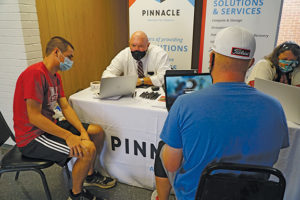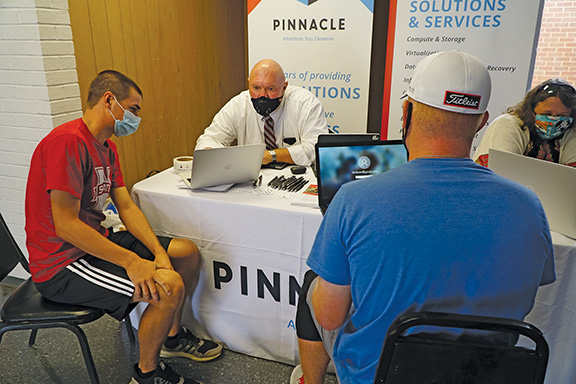by Jordan Green, News Editor

Representatives from Northwestern’s new wireless internet provider visited the campus Tuesday to answer questions about the university’s new WiFi systems.
Alan Bunyard, a network engineer with Edmond-based Pinnacle Business Solutions, talked about the bandwidth the new system offers. He also said the new WiFi systems are helpful to students who play video games, and he addressed the most common problem students have faced when trying to sign-on with the new network: remembering their passwords.
The university purchased the new wireless systems and installed them in residence halls during the summer for roughly $450,000.
Q: Thank you for your time, Mr. Bunyard. First of all, tell me about what this new system is.
A: It is a contiguous system through all of the residential halls, so that means, once connected, your wireless experience should be the same, whether you’re in your own room, in the common areas, the cafeteria, or go to a friend’s room in another hall.
That means, if you hook up a device of your own, like a printer or something that’s on the wireless, you can actually be in a friend’s room and print it, and you don’t have to go in any special location. Basically, your experience should follow you around.
With that, your student login is a personal area network. What that essentially means, it’s kind of like having a “home” experience on a shared platform. I want to connect things I might not normally connect to the school network, like an Amazon Alexa or the Google Homes, and all those IOT kind of devices that – you’re going to be able to connect them to our network that’s private to you.
So when you do connect your personal printer, or you do connect your – some students have a NASH unit, like media students who are storing video files and things like that.
A student came by earlier who is running a website. All of those things are going to be possible, and they’ll be on your personal network. They’ll only be accessible to you unless we do something intentionally to share them with someone else, which that is a thing we can talk about as we move a little further forward.
Students would be able to do things like share printers if they wanted to. Certain things like universal “plug-n-play” is important for gaming systems.
That’s Playstation 4s, your Xbox Ones, or any of the new systems that are coming out, and that’s just a way that your game system tells the Edge firewall, “Hey, I need those ports so that I can connect outside users” if you’re, like, hosting a game or whatever.
So universal “plug-n-play” gives you the best NAT. Gamers are going to know what NAT means because they get that warning when they’re on there. I don’t know what they call it, it’s like an “unfriendly NAT condition” or whatever it is.
They’re looking for a certain thing on there. It’s kind of a “thumbs-up.” It’s automatic. With gaming systems, it’s going to port forward for them, something that wouldn’t normally happen on a campus or … “enterprise” network because it’s not designed for video games. But this particular system is designed to accommodate that.
Q: What is the wireless coverage like?
A: It’s a little different in every dorm. Coronado [Hall] here has three rooms in kind of a “suite” with a shared area. We put an AP [access point] in every single group of three rooms.
In the halls that are more traditional, with one room, two beds, and maybe connected with suite mates or whatever, it’s every other room has an AP.
It actually has such coverage that you could even have an access point fail, and you shouldn’t notice because we’ve overlapped them enough. …
And it also means that you’re not having to share that wireless access point with 100 people, you’re going to be sharing it with, like, five.
So … it should be a very quick experience with the wireless.
Q: What should students know about the bandwidth the new systems offer?
A: That’s actually a little fluid. It’s backed up by an enterprise circuit that’s gigabit speed. And of course, we’re sharing it between almost – well, I think there’s up to 850 students in the residence halls, at max. I don’t know where we’re at this year.
But we limit the speed per student to 25 megabits, and it bursts to 100 megabits.
The reason we do that way is, if you are, say, downloading files, you’re going to be limited to that 25 functionally over a period of time.
But when you’re browsing the internet, you want it to be snappy. … So for the first 10 seconds of anything you do, it’ll burst to 100.
You’ll have a very quick experience browsing the internet and going to stuff.
It’s fast enough to stream 4K. If you want to stream 4K from Netflix, you can totally do that. And it won’t have any impact on anybody else.
Q: What improvements to the systems could we see in the future?
A: There’s some land-party modes, which would be a way to create a temporary land-party.
We may set up some permanently in the residence halls, and that would be, you disconnecting your Xbox from your personal network and then logging it into the land-party, and that way, when you’re all sitting in, say, one of the game rooms with your TVs set up right beside each other, you’re all on the same network, and you don’t have to game out to the internet, so you have really fast ping times, and you’re all sitting in one room.
It’ll be a pretty niche audience probably, but that’s something that we want to set up at some point is the land-party ability.
Q: What are some of the biggest challenges students have faced with the new systems so far?
A: The biggest challenge is that more than half of the students don’t remember their email password. It’s one of those things that you “fire and forget,” get logged in one time in your browser, say “Save that password,” and then you don’t really remember it.
You type it in four or five times wrong, and now they can’t log in because they’ve locked their accounts. So we have had some challenges with the passwords, and we’re working on getting the campus IT [department] to give us a way to reset those passwords for students when it comes up.
But yeah, that’s been the majority of the issues we’ve had today.

